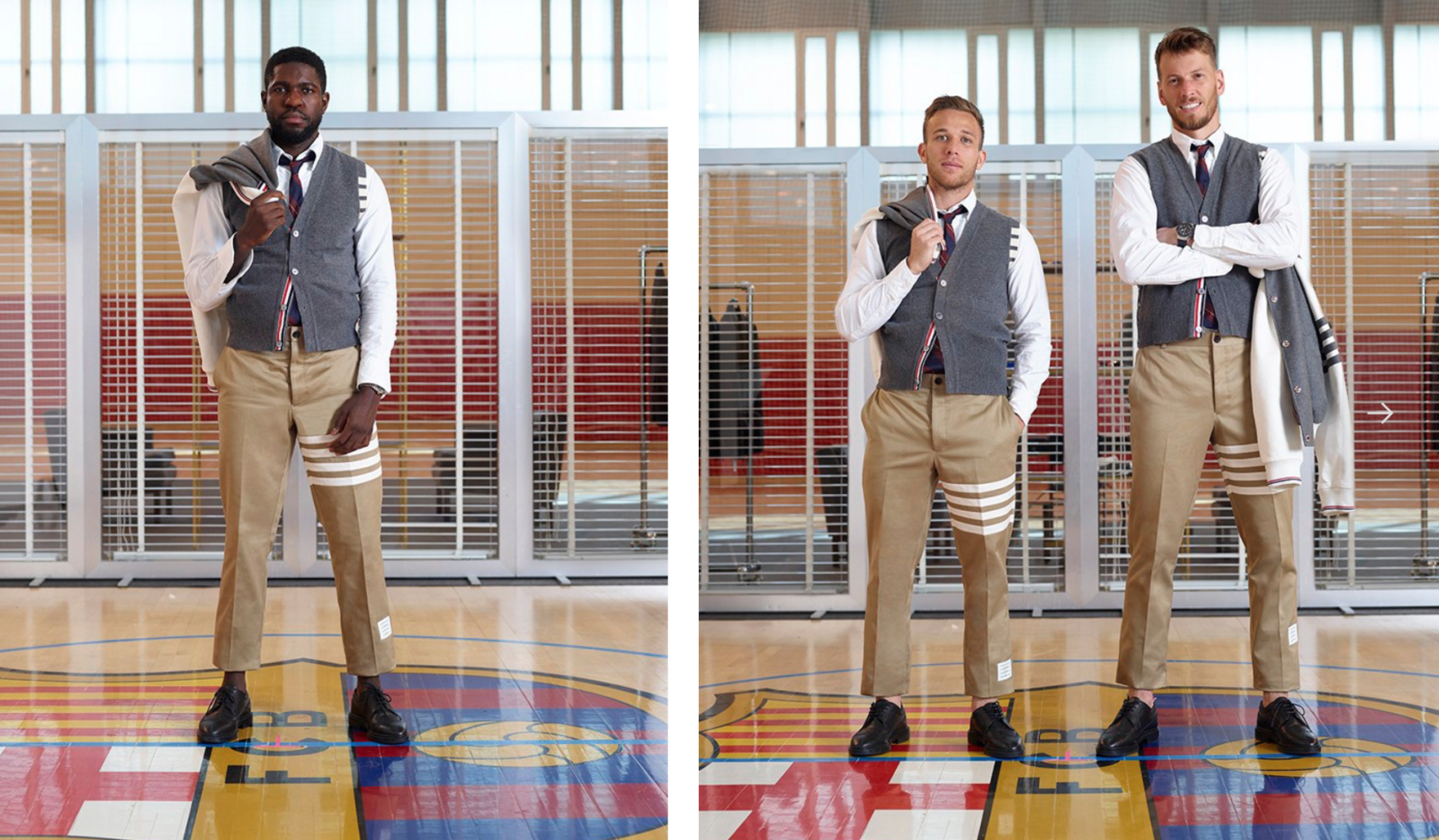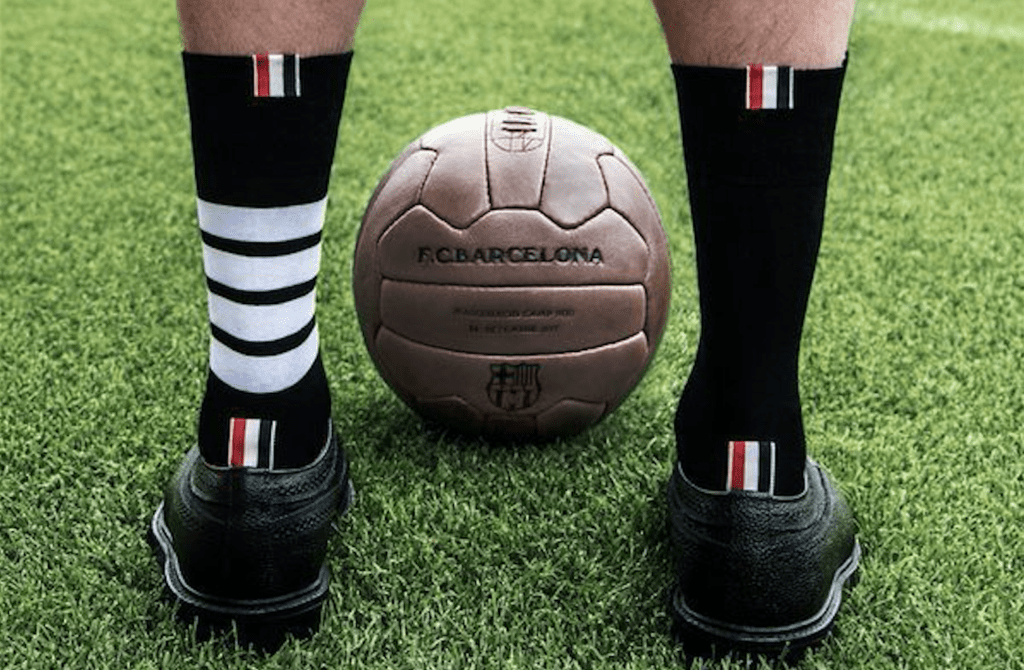In July 2018, just weeks ahead of the start of the 2018–19 La Liga season, FC Barcelona announced a fashion-y, new tie-up. The Spanish soccer club had enlisted designer Thom Browne to create custom made-to-measure suits for its players – including would-famous forward Lionel Messi – to wear during travel for “Champions League and some La Liga away matches,” according to a release, as part of a larger, three-year long deal between the team and the fashion brand.
“In the world of sponsorships for leading athletes [and sports teams as a whole], the obvious choices tend to skew towards recognizable lifestyle brands rather than a niche fashion label,” Forbes’ Taylor Boozan wrote at the time, but the latter is precisely what FC Barcelona opted for when it selected New York-based Browne to design “medium grey two-ply Fresco suits, white oxford shirts, ties, cashmere vests and black pebble grain leather brogues” for the team to wear during certain work-related travel.
While the uniform was exactly on-brand for Thom Browne, given its razor-sharp focus on modern suiting, one distinct element was largely downplayed in the team’s new get-ups: Browne’s signature 4-stripe trademark. Look closely at the players’ 2018–19 cardigans, socks, and shoes, and you will see that they bear red-white-and blue-lined accents but these touches are a far cry from how prominently Browne’s four-stripes have been displayed on many non-team garments, such as those on the designer’s runway each season.
That has changed, however. In FC Barcelona’s portrait for the 2019–20 season (and en route to Sunday’s game against Atlético Madrid), players appeared in their newest Thom Browne off-pitch uniforms, which consist of khaki chinos accented with four bold lines on their left pantlegs and, varsity jackets complete with the same, bold stripes on the right sleeve. Any subtlety around Browne’s stripes is gone, thereby, raising a question about how this move will play out from a legal perspective with adidas.
Given the notoriously litigious stance of the German sportswear giant when it comes to others’ use of stripes, it is worth pondering what will come of Nike-affiliated FC Barcelona’s new uniforms, after all a few factors certainly appear to weigh in favor of a potential problem with the four-stripes.
For one thing, adidas has not been shy about going after others’ uses of stripes in the past. As Judge Garr King – formerly of the U.S. District Court for the District of Oregon– summarized in 2008 in an opinion in the case that adidas filed against the now-defunct Payless Shoes: between 1995 and 2008, “adidas pursued over 325 infringement matters involving the three-stripe mark in the United States, filed more than 35 separate lawsuits for infringement of the three-stripe mark, and entered into more than 45 settlement agreements with companies” selling allegedly infringing striped wares.
 FC Barcelona’s 2019–20 season uniforms
FC Barcelona’s 2019–20 season uniforms
Since then, adidas has not slowed its roll, and has initiated subsequent stripes-specific actions against companies ranging from Tesla to Juicy Couture and Forever 21, the latter of which characterized adidas as an overly-litigious “bully.”
Beyond adidas’ general dedication to policing others’ allegedly infringing use of its various 3-stripe trademarks, it has taken on FC Barcelona in the past. In October 2016, adidas opposed FC Barcelona’s U.S. trademark application for registration of a mark that “consists of a square containing seven vertical stripes (the 1st, 3rd, 5th and 7th stripes from the left are blue, and the remaining three stripes are garnet).” According to adidas, the team’s mark was far too similar to adidas’ own three-stripe trademarks, which are “particularly [are] well known among professional soccer players, fans and consumers of soccer apparel.”
In February 2017, FC Barcelona – which maintains an official and longstanding partnership with adidas’ rival Nike for its on-the-field kits – withdrew its application, suggesting that the two may have come to a behind-the-scenes agreement.
Still yet, it is worth noting that while adidas’ expansive arsenal of trademarks exclusively consist of three-striped logos, that has not stopped the sportswear giant from taking on others over the use of 2 or even 4 stripes. As Skechers asserted in the lawsuit it filed early this year, it received two “infringement notice” letters from adidas in 2018, in which adidas claimed that Skechers’ four-stripe bearing Goldie-Peaks Shoe “infringes and dilutes adidas’s” wildly valuable three-stripe trademark.
Finally, this would not be the first time that adidas has taken on Thom Browne’s marks. As recently as February 2018, adidas took issue with a five-stripe mark that Browne is seeking to register with the European Union Intellectual Property Office (“EUIPO”). In a formal opposition filed with the EUIPO, counsel for adidas argued that Browne’s mark – which consists of “five contiguous vertical bands” of varying colors – should be rejected because such a registration would cause a likelihood of confusion with adidas’ existing marks, and give rise to an “unfair advantage” for Browne, while causing a “detriment to [the] distinctiveness or repute [of adidas’]” trademarks. (That matter is still underway.)
Taken together, these factors – paired with Thom Browne’s increasingly close proximity to adidas’ home turf in terms of its goods/services – might not bode well for FC Barcelona and Browne. And chances are, neither does Browne’s particular use of the stripes, themselves. Unlike most brands’ use of stripes on garments and accessories, which traditionally serve a purely aesthetic or decorative purpose, Browne’s stripes are different; the brand does not merely use stripes to embellish clothing but instead, to indicate to consumers that a product bearing those stripes comes from Thom Brown, much like adidas’ own three-stripe logos.
This distinction is significant because simple, decorative uses of stripes cannot be infringing. Trademark law holds that infringement can only come as a result of use of a mark (including a logo) as a mark. As such, in the (hypothetical) case at hand, if faced with claims of trademark infringement, Browne and FC Barcelona might have a difficult time arguing that infringement is not in play.
While no such proceedings have been initiated by adidas (yet?), this could prove an interesting collaboration to watch either way.











